Lonnie Pacelli's Blog, page 78
May 3, 2014
Lie About Your Credentials, Kill Your Career
Excerpted from The Truth about Getting Your Point Across…and Nothing But the Truth
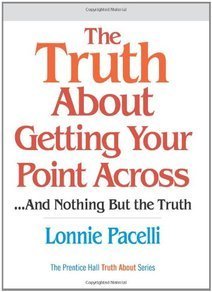 Notre Dame football coach George O’Leary resigned five days after being hired, admitting he lied about his academic and athletic background. O'Leary claimed to have a master's degree in education and to have played college football for three years, but checks into his background showed it wasn't true.
Notre Dame football coach George O’Leary resigned five days after being hired, admitting he lied about his academic and athletic background. O'Leary claimed to have a master's degree in education and to have played college football for three years, but checks into his background showed it wasn't true.
Veritas CFO Kenneth Lonchar was fired because he claimed he had a Masters of Business Administration from Stanford University. Further research showed that he did not hold an MBA from any school. Ironically, Veritas in Latin means “truth”.
Joseph Ellis, a Pulitzer Prize-winning historian, was suspended for a year from Mount Holyoke College for lying about serving in the Vietnam War.
Each of these examples, while high-profile and extreme, all fell from the same tree; people lying on their resumes to help influence an employer to hire them. Aside from the fact that each of the above cases resulted in job loss or suspension; they also all endured the humiliation of being publicly labeled as a liar. Not the best way to be remembered.
Resumes by nature are meant to inform, impress, and inspire a potential employer and get the employer to want to talk to you. Most employers only spend about twenty seconds looking at each resume they receive, and worse, most employers view the information contained on resumes as a way to weed out applicants . Putting your best foot forward to present a concise, compelling case for why you should be hired is crucial to getting you invited to the party.
Amazon.com Widgets Throughout my career I’ve interviewed hundreds of candidates for a wide variety of jobs. Many of the candidates that I’ve interviewed were upstanding, honest, and candid and went on to have successful careers at my company. Of those who didn’t get hired, many lost out because of boastful claims made on their resume that they were unable to substantiate during the interview process. As an interviewer, I intentionally focused on claims that were exceptional to truly understand how they did it and to see if the claim was authentic or bogus. Authentic claims went a long way toward recommending a “hire” decision; bogus claims got an automatic “no hire” without further consideration.
Let me put this as plainly as I can. Lies about your credentials can permanently kill your career. Putting bogus, or even mildly aggressive, claims on your resume can hurt you in a couple of ways. The first question that arises pertains to competence. Bogus claims will cause a potential employer to question whether you possess the skills required to perform the job. The second question, which is far more important for me, pertains to integrity. If a candidate is willing to stretch the truth on a single fact on his or her resume, what else is he or she not being truthful about? Having your integrity questioned by the interviewer is pretty much your one-way ticket home.
The lesson learned here is simple; any lie, even the littlest of white lies, has no place on a resume and will come back to bite you. Assume that each and every word on your resume is going to be checked, questioned, and scrutinized during an interview and verification. Be able to substantiate facts, metrics, and credentials with backup information and provide references where necessary.
Having said all this, do your best to sell yourself on your resume and dazzle prospective employers with your accomplishments, credentials, and experience. Wow them during your twenty seconds of fame. Just make sure that what they see is you and not some figment of your imagination.
 Notre Dame football coach George O’Leary resigned five days after being hired, admitting he lied about his academic and athletic background. O'Leary claimed to have a master's degree in education and to have played college football for three years, but checks into his background showed it wasn't true.
Notre Dame football coach George O’Leary resigned five days after being hired, admitting he lied about his academic and athletic background. O'Leary claimed to have a master's degree in education and to have played college football for three years, but checks into his background showed it wasn't true. Veritas CFO Kenneth Lonchar was fired because he claimed he had a Masters of Business Administration from Stanford University. Further research showed that he did not hold an MBA from any school. Ironically, Veritas in Latin means “truth”.
Joseph Ellis, a Pulitzer Prize-winning historian, was suspended for a year from Mount Holyoke College for lying about serving in the Vietnam War.
Each of these examples, while high-profile and extreme, all fell from the same tree; people lying on their resumes to help influence an employer to hire them. Aside from the fact that each of the above cases resulted in job loss or suspension; they also all endured the humiliation of being publicly labeled as a liar. Not the best way to be remembered.
Resumes by nature are meant to inform, impress, and inspire a potential employer and get the employer to want to talk to you. Most employers only spend about twenty seconds looking at each resume they receive, and worse, most employers view the information contained on resumes as a way to weed out applicants . Putting your best foot forward to present a concise, compelling case for why you should be hired is crucial to getting you invited to the party.
Amazon.com Widgets Throughout my career I’ve interviewed hundreds of candidates for a wide variety of jobs. Many of the candidates that I’ve interviewed were upstanding, honest, and candid and went on to have successful careers at my company. Of those who didn’t get hired, many lost out because of boastful claims made on their resume that they were unable to substantiate during the interview process. As an interviewer, I intentionally focused on claims that were exceptional to truly understand how they did it and to see if the claim was authentic or bogus. Authentic claims went a long way toward recommending a “hire” decision; bogus claims got an automatic “no hire” without further consideration.
Let me put this as plainly as I can. Lies about your credentials can permanently kill your career. Putting bogus, or even mildly aggressive, claims on your resume can hurt you in a couple of ways. The first question that arises pertains to competence. Bogus claims will cause a potential employer to question whether you possess the skills required to perform the job. The second question, which is far more important for me, pertains to integrity. If a candidate is willing to stretch the truth on a single fact on his or her resume, what else is he or she not being truthful about? Having your integrity questioned by the interviewer is pretty much your one-way ticket home.
The lesson learned here is simple; any lie, even the littlest of white lies, has no place on a resume and will come back to bite you. Assume that each and every word on your resume is going to be checked, questioned, and scrutinized during an interview and verification. Be able to substantiate facts, metrics, and credentials with backup information and provide references where necessary.
Having said all this, do your best to sell yourself on your resume and dazzle prospective employers with your accomplishments, credentials, and experience. Wow them during your twenty seconds of fame. Just make sure that what they see is you and not some figment of your imagination.
Published on May 03, 2014 13:42
Babbling is for Babies, Not Interviews
Excerpted from The Truth about Getting Your Point Across…and Nothing But the Truth
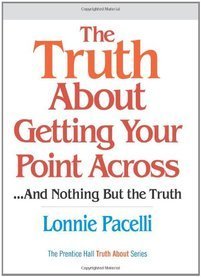 Some years back I was interviewing candidates for a financial analyst position.
Some years back I was interviewing candidates for a financial analyst position.
One of my interviews was with a gentleman who was already a company employee but was looking for a new job within the company. I started out the interview with the question, “What interests you about this job?” The fellow started into a response, and then launched into tangents about his family, prior jobs, and personal interests. About five minutes into the interview I’d already made my decision to not hire the guy, but I was intrigued by his verbal meandering.
I decided to let him keep going just to see where he would go. He finally stopped talking 30 minutes after I asked him my original question. My next question to him was “Do you realize you talked non-stop for 30 minutes?” Before he could launch into another wandering discourse, I thanked him for stopping by and told him that I didn’t think he was right for the job. He very well might have had the technical and business skills needed to do the job, but because he babbled on and on without clarity of thought he was declined.
The demonstration of clear, concise thoughts through responses to interview questions is a major factor for your interviewer in deciding whether or not to hire you. When responding to questions, your interviewer is not only listening to your answers but also imagining you talking with colleagues, suppliers, customers, or executives. If you, as an interviewee, aren’t able to respond with crisp, concise, thoughtful answers during an interview, imagine how you would come off in a major customer presentation? You may have some insightful things to say, but if they get lost in long, meandering responses then you’re going to seal your fate as a declined candidate.
Amazon.com Widgets Next time you interview for a job, keep the following things in mind:
Target your responses around a key message – When asked a question, formulate your response around a key message or a series of key messages. State your key message first, and then provide a couple of sentences which support the key message. Know what your key message is before you start talking, otherwise your response will meander.
Watch the interviewer for frustration – Look for cues that the interviewer is impatient, confused, or bored. The best interviews I’ve done have been where an interviewee captured my interest by a stating a key message and we were just able to talk. Look to capture an interviewer’s interest; if he or she doesn’t look interested, wrap up your point and stop talking.
Keep eye contact with the interviewer – Keeping eye contact with the interviewer will help you to stick to your key message because you won’t get distracted. Keeping eye contact also demonstrates conviction and confidence. Wandering eyes feel evasive and can contribute to babbling.
Take a breath before you respond – Let the interviewer finish his question before you start responding. Take a second after the question, get your key message in your head, then start your answer. Being too eager to answer the question will contribute to drifting from your key message and will brand you as being rude.
Don’t argue with yourself – Don’t play point/counter-point with yourself. When asked a question, formulate your key message and take a stand in your response. It’s OK to briefly identify the other side of an argument, but make sure you state a key message and don’t give the perception that you are indecisive.
Provide context to your answers – Don’t just give “yes” or “no” – type answers without providing a bit of context behind the response. The interviewer not only wants to know what your answer is, but something about why you think the way you do. Be cautious about drifting on and on with your answer; make a couple of statements that support your key message then clam up.
Ask your interviewer for feedback – At the end of the interview, consider asking the interviewer to provide some feedback to you on how they think the interview went. Specifically ask about the quality and conciseness of your responses. Just be careful not to get into an argument about the interviewer’s feedback; listen politely and thank them for the feedback. Don’t create a negative impression with the interviewer because you argued or got defensive over any feedback you received.
It’s easy when nervous or excited to babble on and on and lose focus in your responses to questions. Formulate key messages, keep eye contact, watch your interviewer, and take a stand with your responses. You’ll better engage your interviewer, captivate interest, and help to secure the job you want.
 Some years back I was interviewing candidates for a financial analyst position.
Some years back I was interviewing candidates for a financial analyst position. One of my interviews was with a gentleman who was already a company employee but was looking for a new job within the company. I started out the interview with the question, “What interests you about this job?” The fellow started into a response, and then launched into tangents about his family, prior jobs, and personal interests. About five minutes into the interview I’d already made my decision to not hire the guy, but I was intrigued by his verbal meandering.
I decided to let him keep going just to see where he would go. He finally stopped talking 30 minutes after I asked him my original question. My next question to him was “Do you realize you talked non-stop for 30 minutes?” Before he could launch into another wandering discourse, I thanked him for stopping by and told him that I didn’t think he was right for the job. He very well might have had the technical and business skills needed to do the job, but because he babbled on and on without clarity of thought he was declined.
The demonstration of clear, concise thoughts through responses to interview questions is a major factor for your interviewer in deciding whether or not to hire you. When responding to questions, your interviewer is not only listening to your answers but also imagining you talking with colleagues, suppliers, customers, or executives. If you, as an interviewee, aren’t able to respond with crisp, concise, thoughtful answers during an interview, imagine how you would come off in a major customer presentation? You may have some insightful things to say, but if they get lost in long, meandering responses then you’re going to seal your fate as a declined candidate.
Amazon.com Widgets Next time you interview for a job, keep the following things in mind:
Target your responses around a key message – When asked a question, formulate your response around a key message or a series of key messages. State your key message first, and then provide a couple of sentences which support the key message. Know what your key message is before you start talking, otherwise your response will meander.
Watch the interviewer for frustration – Look for cues that the interviewer is impatient, confused, or bored. The best interviews I’ve done have been where an interviewee captured my interest by a stating a key message and we were just able to talk. Look to capture an interviewer’s interest; if he or she doesn’t look interested, wrap up your point and stop talking.
Keep eye contact with the interviewer – Keeping eye contact with the interviewer will help you to stick to your key message because you won’t get distracted. Keeping eye contact also demonstrates conviction and confidence. Wandering eyes feel evasive and can contribute to babbling.
Take a breath before you respond – Let the interviewer finish his question before you start responding. Take a second after the question, get your key message in your head, then start your answer. Being too eager to answer the question will contribute to drifting from your key message and will brand you as being rude.
Don’t argue with yourself – Don’t play point/counter-point with yourself. When asked a question, formulate your key message and take a stand in your response. It’s OK to briefly identify the other side of an argument, but make sure you state a key message and don’t give the perception that you are indecisive.
Provide context to your answers – Don’t just give “yes” or “no” – type answers without providing a bit of context behind the response. The interviewer not only wants to know what your answer is, but something about why you think the way you do. Be cautious about drifting on and on with your answer; make a couple of statements that support your key message then clam up.
Ask your interviewer for feedback – At the end of the interview, consider asking the interviewer to provide some feedback to you on how they think the interview went. Specifically ask about the quality and conciseness of your responses. Just be careful not to get into an argument about the interviewer’s feedback; listen politely and thank them for the feedback. Don’t create a negative impression with the interviewer because you argued or got defensive over any feedback you received.
It’s easy when nervous or excited to babble on and on and lose focus in your responses to questions. Formulate key messages, keep eye contact, watch your interviewer, and take a stand with your responses. You’ll better engage your interviewer, captivate interest, and help to secure the job you want.
Published on May 03, 2014 13:40
April 26, 2014
Watch the Pontificator!
Excerpted from The Truth about Getting Your Point Across…and Nothing But the Truth
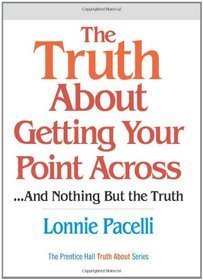 At the offices of one of my clients there was a fellow who I’ll call “Moe.” Moe was your typical pontificator. At any time we saw Moe he was standing outside of someone’s cubicle or sitting on someone’s office, coffee cup in hand, waxing poetic about the latest dumb decision management made, the idiots that run his division, or last night’s baseball game. Moe had an opinion on everything and was very free about letting you know every detail of his opinion.
At the offices of one of my clients there was a fellow who I’ll call “Moe.” Moe was your typical pontificator. At any time we saw Moe he was standing outside of someone’s cubicle or sitting on someone’s office, coffee cup in hand, waxing poetic about the latest dumb decision management made, the idiots that run his division, or last night’s baseball game. Moe had an opinion on everything and was very free about letting you know every detail of his opinion.
There was no such thing as a five-minute conversation with Moe.
Unless you excused yourself for whatever reason you were there for at least fifteen minutes listening to his philosophy. The problem was that Moe was friends with the person managing our contract so we had to put up with him.
Moe was particularly problematic during meetings. He diverted agendas, disrupted meeting topics, and wasted tremendous amounts of time. Despite all this, Moe was a long-time company employee and understood his job well. But he was still a big pain in the hindquarters.
It’s likely that that you’ve worked with a person like Moe. You can do your best to avoid him, but there he is, ready to give you an earful about something. So how do you handle the Moes of the world during meetings? How do you keep things on track? How do you avoid frustrating everyone else in the meeting when the pontificator revs up his engine?
Amazon.com Widgets The first thing you can do about the pontificator at your meeting is to take a good hard look at whether the pontificator absolutely needs to be at the meeting. Will the pontificator contribute valuable content and perspective that will add value to the meeting? If not avoid having the pontificator at the meeting in the first place.
If the pontificator needs to be there, try to talk with him beforehand and solicit his help in keeping the meeting moving forward. Spend a few minutes reviewing the agenda and get him oriented to the meeting topic. If he has opinions or viewpoints that he wants to air, get him to do it with you beforehand and try to incorporate some of his viewpoint into the topic. If he sees that he has been heard and if some of his thinking is baked into your agenda, the pontificator is more likely to be a good soldier and not hijack your meeting.
If you’ve taken this step and the pontificator still feels the need to take control of your meeting, your next mission is to preserve the purpose of the meeting, keep things focused on the agenda, and avoid wasting any of the other attendee’s time. It is vitally important that you monitor what your pontificator is saying and keep them focused on the agenda item. If he continues to drift off topic onto his own agenda item ask to have the item taken offline. If it continues then it is completely within bounds to cut the person off and bring things back to your agenda. Whatever you do, don’t lose control of the agenda. Your credibility is at stake with other meeting attendees; losing control of the agenda means a loss of credibility, which you’ll now need to work to regain.
Pontificators don’t have to spell doom and gloom to your meetings. If you can ensure that they truly need to be involved in the meeting, get them on your side, and control them when they veer off path, you can still get things done when they are involved.
 At the offices of one of my clients there was a fellow who I’ll call “Moe.” Moe was your typical pontificator. At any time we saw Moe he was standing outside of someone’s cubicle or sitting on someone’s office, coffee cup in hand, waxing poetic about the latest dumb decision management made, the idiots that run his division, or last night’s baseball game. Moe had an opinion on everything and was very free about letting you know every detail of his opinion.
At the offices of one of my clients there was a fellow who I’ll call “Moe.” Moe was your typical pontificator. At any time we saw Moe he was standing outside of someone’s cubicle or sitting on someone’s office, coffee cup in hand, waxing poetic about the latest dumb decision management made, the idiots that run his division, or last night’s baseball game. Moe had an opinion on everything and was very free about letting you know every detail of his opinion.There was no such thing as a five-minute conversation with Moe.
Unless you excused yourself for whatever reason you were there for at least fifteen minutes listening to his philosophy. The problem was that Moe was friends with the person managing our contract so we had to put up with him.
Moe was particularly problematic during meetings. He diverted agendas, disrupted meeting topics, and wasted tremendous amounts of time. Despite all this, Moe was a long-time company employee and understood his job well. But he was still a big pain in the hindquarters.
It’s likely that that you’ve worked with a person like Moe. You can do your best to avoid him, but there he is, ready to give you an earful about something. So how do you handle the Moes of the world during meetings? How do you keep things on track? How do you avoid frustrating everyone else in the meeting when the pontificator revs up his engine?
Amazon.com Widgets The first thing you can do about the pontificator at your meeting is to take a good hard look at whether the pontificator absolutely needs to be at the meeting. Will the pontificator contribute valuable content and perspective that will add value to the meeting? If not avoid having the pontificator at the meeting in the first place.
If the pontificator needs to be there, try to talk with him beforehand and solicit his help in keeping the meeting moving forward. Spend a few minutes reviewing the agenda and get him oriented to the meeting topic. If he has opinions or viewpoints that he wants to air, get him to do it with you beforehand and try to incorporate some of his viewpoint into the topic. If he sees that he has been heard and if some of his thinking is baked into your agenda, the pontificator is more likely to be a good soldier and not hijack your meeting.
If you’ve taken this step and the pontificator still feels the need to take control of your meeting, your next mission is to preserve the purpose of the meeting, keep things focused on the agenda, and avoid wasting any of the other attendee’s time. It is vitally important that you monitor what your pontificator is saying and keep them focused on the agenda item. If he continues to drift off topic onto his own agenda item ask to have the item taken offline. If it continues then it is completely within bounds to cut the person off and bring things back to your agenda. Whatever you do, don’t lose control of the agenda. Your credibility is at stake with other meeting attendees; losing control of the agenda means a loss of credibility, which you’ll now need to work to regain.
Pontificators don’t have to spell doom and gloom to your meetings. If you can ensure that they truly need to be involved in the meeting, get them on your side, and control them when they veer off path, you can still get things done when they are involved.
Published on April 26, 2014 21:19
Drive A Tight Agenda, Don't Let It Drive You
Excerpted from The Truth about Getting Your Point Across…and Nothing But the Truth
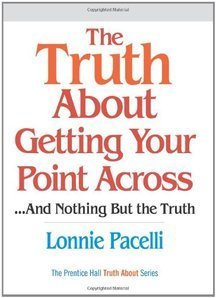 A colleague of mine was responsible for running a bi-weekly two-hour team meeting. He took great care to develop a very full, detailed agenda. As we would get into the meeting, it would only take us getting to agenda item one before the meeting was behind schedule.
A colleague of mine was responsible for running a bi-weekly two-hour team meeting. He took great care to develop a very full, detailed agenda. As we would get into the meeting, it would only take us getting to agenda item one before the meeting was behind schedule.
During the entire time that my colleague ran these meetings, we never got more than halfway through the agenda before adjourning. The team got so used to not making it through the agenda that there wasn’t even an attempt to try to stay on schedule. The agenda and associated times were completely unrealistic and were worthless as a meeting management tool.
An effective agenda goes beyond start time, location, topics, and durations. Effective agendas do the following:
Support the meeting purpose Set the expectations of attendees as to what will be discussed Inform attendees of any preparation that will be required prior to the meeting Give the meeting leader a roadmap for driving the agenda
Permit adequate time to cover each item
Allow the meeting leader to adjust the agenda easily if the meeting gets behind schedule Amazon.com Widgets Having said all this, there is a guiding principle the meeting owner needs to follow: The meeting owner drives the agenda, not the other way around. There are times where you may have a concise meeting purpose and specific agenda items to address the meeting purpose, but the actual meeting deviates from the agenda. Be open to the agenda change; just make sure the meeting purpose is still being met. Doing this requires the meeting owner be very in-tune to what is going on in the meeting and footing it back to what is happening on the agenda. If the actual meeting is deviating from the agenda, the meeting owner needs to consciously decide if the deviation is appropriate or if it needs to be nipped in the bud. There’s no secret sauce on this; it means keeping the original meeting’s purpose in mind, observing what is actually happening in the meeting, and continually assessing whether the meeting’s purpose is being met.
So, what are some good tips to developing effective agenda? Consider these next time you have to plan a meeting:
Have a tight, focused meeting purpose – You’ve called the meeting for a reason; make sure that the purpose is explicit and achievable. A good sanity check on this is that you should be able to complete this sentence: “At the end of this meeting we should be able to _______.”
Cross-foot your agenda items with the meeting purpose – As you’re crafting your agenda items, make sure that each item is doing something to support the meeting purpose. If the items don’t support the meeting purpose either change the agenda item or change the purpose. Don’t confuse the attendees by having agenda items that don’t support the meeting purpose
Be realistic with allocated agenda item times – Don’t put overly aggressive times on the agenda that you in your heart know you’re not going to achieve. Planning 90 minutes worth of meeting in 60 minutes means you’ll only get through 2/3 of the meeting or the meeting will run over by at least 30 minutes. Don’t wish for best case; put reality down.
Distribute the agenda at least one day before the meeting – Meeting attendees want to know what is going to be discussed and if there is preparation that is needed prior to the meeting. Give them a day if possible to review the agenda and get mentally prepared for the meeting.
Put the most important agenda items at the front of the meeting – Cover your top items first. There are two reasons for this: first, you’ll ensure that the most important items get covered. Second, you’ll keep attendee attention better by covering the most important items earlier. If they are put later in the agenda then you’ll see some chomping at the bit as you go through lesser important agenda items first.
Have as your last agenda item an “action items review” section – I’ve seen way too many meetings happen in my career where the end of the meeting comes, everyone leaves, but there is no agreement on what actions need to be taken out of the meeting. In your action items review, indicate what the action items are, who is responsible for each action item, and when the action item needs to be completed by. Have a contingency plan in place for when agenda items run over – Even with the best-planned meetings, sometimes agenda items take longer than expected. Have a plan for how you are going to accommodate the change, which could mean shortening some other agenda items or eliminating an agenda item completely
Build tight, realistic, achievable agendas. You’ll get more done, reduce attendee frustration, and make the best use of everyone’s time. Just don’t be a slave to the agenda if you see the agenda won’t accomplish the meeting’s purpose.
 A colleague of mine was responsible for running a bi-weekly two-hour team meeting. He took great care to develop a very full, detailed agenda. As we would get into the meeting, it would only take us getting to agenda item one before the meeting was behind schedule.
A colleague of mine was responsible for running a bi-weekly two-hour team meeting. He took great care to develop a very full, detailed agenda. As we would get into the meeting, it would only take us getting to agenda item one before the meeting was behind schedule.During the entire time that my colleague ran these meetings, we never got more than halfway through the agenda before adjourning. The team got so used to not making it through the agenda that there wasn’t even an attempt to try to stay on schedule. The agenda and associated times were completely unrealistic and were worthless as a meeting management tool.
An effective agenda goes beyond start time, location, topics, and durations. Effective agendas do the following:
Support the meeting purpose Set the expectations of attendees as to what will be discussed Inform attendees of any preparation that will be required prior to the meeting Give the meeting leader a roadmap for driving the agenda
Permit adequate time to cover each item
Allow the meeting leader to adjust the agenda easily if the meeting gets behind schedule Amazon.com Widgets Having said all this, there is a guiding principle the meeting owner needs to follow: The meeting owner drives the agenda, not the other way around. There are times where you may have a concise meeting purpose and specific agenda items to address the meeting purpose, but the actual meeting deviates from the agenda. Be open to the agenda change; just make sure the meeting purpose is still being met. Doing this requires the meeting owner be very in-tune to what is going on in the meeting and footing it back to what is happening on the agenda. If the actual meeting is deviating from the agenda, the meeting owner needs to consciously decide if the deviation is appropriate or if it needs to be nipped in the bud. There’s no secret sauce on this; it means keeping the original meeting’s purpose in mind, observing what is actually happening in the meeting, and continually assessing whether the meeting’s purpose is being met.
So, what are some good tips to developing effective agenda? Consider these next time you have to plan a meeting:
Have a tight, focused meeting purpose – You’ve called the meeting for a reason; make sure that the purpose is explicit and achievable. A good sanity check on this is that you should be able to complete this sentence: “At the end of this meeting we should be able to _______.”
Cross-foot your agenda items with the meeting purpose – As you’re crafting your agenda items, make sure that each item is doing something to support the meeting purpose. If the items don’t support the meeting purpose either change the agenda item or change the purpose. Don’t confuse the attendees by having agenda items that don’t support the meeting purpose
Be realistic with allocated agenda item times – Don’t put overly aggressive times on the agenda that you in your heart know you’re not going to achieve. Planning 90 minutes worth of meeting in 60 minutes means you’ll only get through 2/3 of the meeting or the meeting will run over by at least 30 minutes. Don’t wish for best case; put reality down.
Distribute the agenda at least one day before the meeting – Meeting attendees want to know what is going to be discussed and if there is preparation that is needed prior to the meeting. Give them a day if possible to review the agenda and get mentally prepared for the meeting.
Put the most important agenda items at the front of the meeting – Cover your top items first. There are two reasons for this: first, you’ll ensure that the most important items get covered. Second, you’ll keep attendee attention better by covering the most important items earlier. If they are put later in the agenda then you’ll see some chomping at the bit as you go through lesser important agenda items first.
Have as your last agenda item an “action items review” section – I’ve seen way too many meetings happen in my career where the end of the meeting comes, everyone leaves, but there is no agreement on what actions need to be taken out of the meeting. In your action items review, indicate what the action items are, who is responsible for each action item, and when the action item needs to be completed by. Have a contingency plan in place for when agenda items run over – Even with the best-planned meetings, sometimes agenda items take longer than expected. Have a plan for how you are going to accommodate the change, which could mean shortening some other agenda items or eliminating an agenda item completely
Build tight, realistic, achievable agendas. You’ll get more done, reduce attendee frustration, and make the best use of everyone’s time. Just don’t be a slave to the agenda if you see the agenda won’t accomplish the meeting’s purpose.
Published on April 26, 2014 21:19
Managing Outsourced Relationships
 More and more companies are outsourcing everything from IT to call centers to facilities management. Measuring the effectiveness of the outsourcer is crucial and can mitigate tons of downstream issues for both companies. Consider the following to help you better measure outsourcer effectiveness:
More and more companies are outsourcing everything from IT to call centers to facilities management. Measuring the effectiveness of the outsourcer is crucial and can mitigate tons of downstream issues for both companies. Consider the following to help you better measure outsourcer effectiveness:Get crisp agreement on what will be measured - Be as quantitative as possible with measures and ensure that the measures matter. It is easy to create scads of measures that no one really looks at, except for the poor analyst who has to spend hours putting the measures together.
Know what you're going to do if measures turn unfavorable - So you've got these great measures, and all of a sudden one of them starts turning south. Knowing potential courses of action when measures turn unfavorable help you take better and more effective action as opposed to responding in crisis mode.
Amazon.com Widgets Be realistic - Just because you've outsourced a function doesn't mean there will be dramatic improvement right off the bat. Develop realistic improvement benchmarks which both parties agree to.
Get examples from the outsourcer on measures from other clients - Ask the outsourcer for other client examples and what has worked well/not so well at that client. If you can avoid completely re-creating the wheel, do it.
Agree on regular, standing meetings to review performance measures - Have a standing, periodic meeting where both parties review agreed-upon measures and discuss both successes and challenges. It's super important that the program manager for the outsourcer drive the meeting; don't let the salespeople do it.
Published on April 26, 2014 14:36
April 25, 2014
Autism Awareness Book Launch and Fundraiser
Come to our autism awareness book launch & fundraiser to celebrate Patty's latest book
SIx-Word Lessons for Autism Friendly Workplaces
. Event is May 1 5:30 to 8PM @ Armstrong Winery 19151 144th Ave NE Woodinville WA. Can't make it live? Help us raise awareness by buying one (or more) of the books below. Portion of proceeds go to the Seattle Autism Guild. 
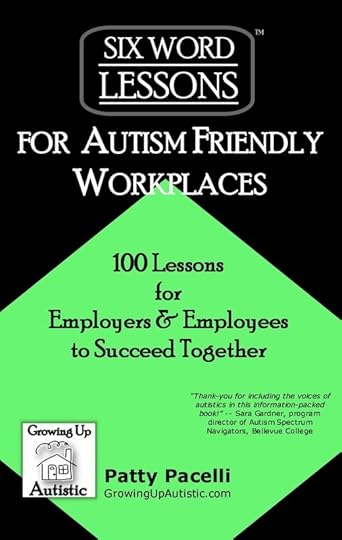


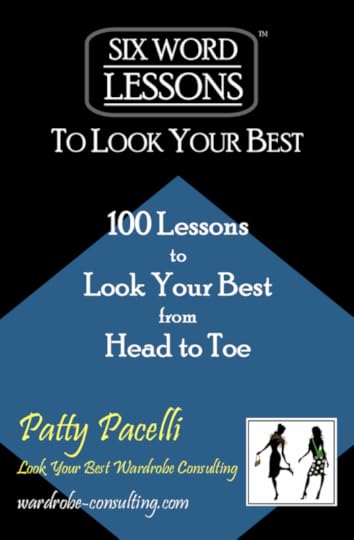
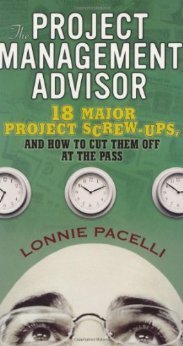
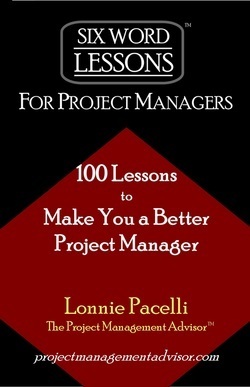

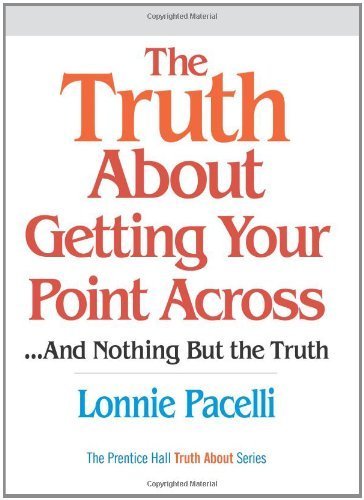











Published on April 25, 2014 10:53
April 23, 2014
Tips to Teach your Kids about Money
 I recently did an interview about tips to use when teaching your kids about money. In thinking through some techniques, I was able to lock on some specific things we did which helped to better instill good money management habits in our kids. Here they are:
I recently did an interview about tips to use when teaching your kids about money. In thinking through some techniques, I was able to lock on some specific things we did which helped to better instill good money management habits in our kids. Here they are:1. When our daughter was in her tweens, we started working with her about purchasing decisions and saving up for things she wanted. Here’s what we did:
o We increased the amount of her allowance, gave it to her quarterly, but then had her use her budget to buy all of her own clothes and other personal items
o We kept track of inflows and outflows on an excel spreadsheet
o If she wanted something we would ask her if that was where she wanted to spend her budget. If she said yes then she made the purchase but then she had to wait until she had enough money in her account to buy other things
o Right after we put this into effect, she and my wife were in Nordstrom and our daughter saw a pair of flip-flops she wanted. She asked my wife if she could get them. My wife responded, “Is that where you want to spend your money?” She ended up buying flip-flops at Target.
2. Both our kids got checking accounts before age 16 and credit cards at age 18. The rationale for doing is that we wanted to make sure they learned about the concept of interest and making payments versus paying their bill in full every month. We wanted them to learn good habits while at home as opposed to learning bad habits while at college. While discussing with our daughter, she asked the question, “You mean if I don’t pay it off in full every month then I’m paying interest to the bank and getting nothing in return?” After I told her that was exactly the case she vowed that she would always monitor her spending so she could pay her bill in full every month. Both our kids are experienced with credit cards and neither has paid a dime in interest charges because they couldn’t pay their bill in full every month.
3. Our eldest is out of college and youngest is still in college. When our eldest got her first job as a nurse we had a deliberate discussion about her saving for retirement. She contributes the maximum amount to her 401k, has saved up enough for six-months of living expenses, and lives off the rest. She drives a ten-year-old car because it’s “good enough”. She still indulges in the nice purse or a weekend away, but does so within her means.
4. Most of the discussion has been about our daughter, but we did the same things with our son. He and his big sister are better disciplined money managers than many adults I know. Oh and our son is also mainstream autistic and still is able to manage his finances like a hawk.
Published on April 23, 2014 11:29
April 19, 2014
From Saul to Paul: How the flawed and imperfect lead through influence
 I recently spoke to 200 men at my church about how flawed and imperfect men lead through influence. Paul's conversion from Saul the persecuting Pharisee who actively sought out followers of Christ to Paul the tireless servant of the Lord is arguably the most influential person in all history. In the presentation I outline twelve attributes of flawed and imperfect leaders who lead through influence just as Paul did two centuries ago. If you'd like a copy of the presentation please download here. If you want to dig deeper on how to boost your leadership skills check out Why Don't They Follow Me? 12 Easy Lessons to Boost Your Leadership Skills.
I recently spoke to 200 men at my church about how flawed and imperfect men lead through influence. Paul's conversion from Saul the persecuting Pharisee who actively sought out followers of Christ to Paul the tireless servant of the Lord is arguably the most influential person in all history. In the presentation I outline twelve attributes of flawed and imperfect leaders who lead through influence just as Paul did two centuries ago. If you'd like a copy of the presentation please download here. If you want to dig deeper on how to boost your leadership skills check out Why Don't They Follow Me? 12 Easy Lessons to Boost Your Leadership Skills.Want to register for the retreat? Go here.
Questions? Email me.
Published on April 19, 2014 20:01
Defining a Meaningful Workplan in MS Project
So okay, Microsoft Project is a super flexible tool in helping you as a project manager define your project tasks, dependencies, and resources. Quite frankly, though, the workplan you define in MS Project is only as good as the thought that goes into it. Too often I've seen savvy MS Project users completely bungle a project because, while the tool was being used appropriately, the workplan didn't make sense to the project team and didn't reflect what really needed to be done. The team consistently expressed confusion about what needed to be done by when because the project workplan wasn't reflective of the actual work which needed to be done. Great exercise in using MS Project, but poor execution of the project. Blech.
As project managers, we need to ensure that a project workplan succinctly satisfies the goal of the project, accurately reflects the work to be performed on the project, and is last but not least easily understood
by the project team. Through the years I've blown a number of projects because I failed to succinctly and clearly define the work appropriately in a way that the rest of the team clearly knew what needed to be done. As I look back on my failures I can point to several factors which led to a fuzzy workplan, as follows:
Unclear project objective - The team was not in unison about the objective of the project and what "done" looked like
Poor task groupings - Tasks were grouped illogically to where each grouping didn't represent a project deliverable or easily definable milestone.
Stale tasks - Tasks in the workplan did not accurately reflect the current work to be performed. As things changed on the project the workplan didn't keep up with the changes.
Maintaining the project workplan became the focus of the project - Rather than focusing on the end deliverable, focus was more on defining the "perfect project" in MS Project. All the features of MS Project were exquisitely used, but the project imploded nonetheless.
As project managers, we all need to ensure that the workplan is a tool we control, not something that controls us. Many younger project managers seek comfort in tools and make the assumption that if the tool
is used properly then the project will succeed. Avoid this mistake by taking the following steps:
Ensure the project objective is easily articulated and understood by the entire project team - Physically write out the project objective and what success looks like for the project. Ensure the team understands the project objective and has no question as to the success criteria. Unless you've got clarity on the objective don't bother going further; you'll just be wasting your time.
Work backwards - Starting with your end deliverable, work backwards to define what things need to be done in order to complete the deliverable. Clearly think in terms of deliverables which can easily be tracked as to completeness. Continue to ask yourself, "For this task to be done, I need to have ________."
Equate logical task groupings to project deliverables - As you break down project tasks try to equate sub-tasks to specific project deliverables. As you define your workplan continue to ask yourself, "How will I know this task is complete?" and "What does the deliverable look like?". By thinking in terms of deliverables you also better ensure that your tasks better reflect the work needing to be done.
Keep it current - As things change on your project make sure your workplan accurately reflects what needs to be performed. Including stale tasks in your workplan creates confusion on the project team and leads to wasted time and money on your project. Do remember to baseline your project prior to making changes so you can see a history of what has changed on the project.
Keep focused on the project objective - This almost sounds like a "no duh", but too many times project managers get so immersed in MS Project that they lose sight of why the project exists in the first place. Keep the project objective prominently displayed as a reminder to you and the project team as to why you're doing the project in the first place.
Your project workplan is the backbone of your project. Ensure the work is clearly articulated, easily understood, and succinctly addresses the project objective. Fail to do so and you'll waste a ton of time and
money learning a painful lesson.
As project managers, we need to ensure that a project workplan succinctly satisfies the goal of the project, accurately reflects the work to be performed on the project, and is last but not least easily understood
by the project team. Through the years I've blown a number of projects because I failed to succinctly and clearly define the work appropriately in a way that the rest of the team clearly knew what needed to be done. As I look back on my failures I can point to several factors which led to a fuzzy workplan, as follows:
Unclear project objective - The team was not in unison about the objective of the project and what "done" looked like
Poor task groupings - Tasks were grouped illogically to where each grouping didn't represent a project deliverable or easily definable milestone.
Stale tasks - Tasks in the workplan did not accurately reflect the current work to be performed. As things changed on the project the workplan didn't keep up with the changes.
Maintaining the project workplan became the focus of the project - Rather than focusing on the end deliverable, focus was more on defining the "perfect project" in MS Project. All the features of MS Project were exquisitely used, but the project imploded nonetheless.
As project managers, we all need to ensure that the workplan is a tool we control, not something that controls us. Many younger project managers seek comfort in tools and make the assumption that if the tool
is used properly then the project will succeed. Avoid this mistake by taking the following steps:
Ensure the project objective is easily articulated and understood by the entire project team - Physically write out the project objective and what success looks like for the project. Ensure the team understands the project objective and has no question as to the success criteria. Unless you've got clarity on the objective don't bother going further; you'll just be wasting your time.
Work backwards - Starting with your end deliverable, work backwards to define what things need to be done in order to complete the deliverable. Clearly think in terms of deliverables which can easily be tracked as to completeness. Continue to ask yourself, "For this task to be done, I need to have ________."
Equate logical task groupings to project deliverables - As you break down project tasks try to equate sub-tasks to specific project deliverables. As you define your workplan continue to ask yourself, "How will I know this task is complete?" and "What does the deliverable look like?". By thinking in terms of deliverables you also better ensure that your tasks better reflect the work needing to be done.
Keep it current - As things change on your project make sure your workplan accurately reflects what needs to be performed. Including stale tasks in your workplan creates confusion on the project team and leads to wasted time and money on your project. Do remember to baseline your project prior to making changes so you can see a history of what has changed on the project.
Keep focused on the project objective - This almost sounds like a "no duh", but too many times project managers get so immersed in MS Project that they lose sight of why the project exists in the first place. Keep the project objective prominently displayed as a reminder to you and the project team as to why you're doing the project in the first place.
Your project workplan is the backbone of your project. Ensure the work is clearly articulated, easily understood, and succinctly addresses the project objective. Fail to do so and you'll waste a ton of time and
money learning a painful lesson.
Published on April 19, 2014 20:01
Be Accessible, Not Open-Door
Excerpted from The Truth about Getting Your Point Across…and Nothing But the Truth
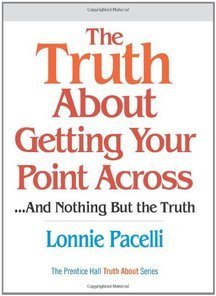 The phrase “I have an open door policy” was very intriguing to me in my early career. As a younger staff person, I envisioned the day when I could be a supportive, empathetic manager who was able to respond to any of my employees’ needs, questions, and comments whenever they needed me. I envisioned people coming to my door (which was open, of course), asking, “Got a minute?” then me leaving my work, talking with the employee, them thanking me for being such an inspirational manager, then me going back to my work and picking up just like I never left it. Ah, the naiveté.
The phrase “I have an open door policy” was very intriguing to me in my early career. As a younger staff person, I envisioned the day when I could be a supportive, empathetic manager who was able to respond to any of my employees’ needs, questions, and comments whenever they needed me. I envisioned people coming to my door (which was open, of course), asking, “Got a minute?” then me leaving my work, talking with the employee, them thanking me for being such an inspirational manager, then me going back to my work and picking up just like I never left it. Ah, the naiveté.
When I actually became a manager, I shortly thereafter gave my empathetic, “I have an open door policy” speech and was ready to solve problems for anyone who crossed my threshold.
Within a few months of my open door policy, I saw my own productivity drop and my frustration level rise because I kept getting interrupted by people taking me up on my open-door policy. My open-door policy soon turned into a series of random interruptions that caused me to not get my stuff done. I came to recognize that I needed to be accessible to people but that I could control the accessibility through scheduled time. Open-door means be accessible, not come in whenever you want.
I realize that I am in some ways debunking a philosophy that a lot of people subscribe to. I also don’t want to be so regimented in my depiction that you think I never permitted drop-ins. Quite the contrary, I really liked the occasional chit-chat or quick questions at the right times. The “be accessible” policy means that you welcome and encourage people to come talk to you, but as a general rule should schedule time with you just as the requestor would with any other meeting that happens in your organization. Dropping in whenever the requestor feels like it shouldn’t be encouraged, particularly when you’re already busy.
Amazon.com Widgets Also, “be accessible” doesn’t mean you’ll just see anyone about anything. Depending on your level in the organization and your degree of influence, you can spend the vast majority of your time meeting with people that will either want to sell you something or will want an audience to air their personal grievances. When you get requests for your time, it’s a good idea to ask what the requestor would like from you. You can then make an assessment of whether it is appropriate to meet with the requestor or to suggest another person the requestor should contact.
The “be accessible policy” works, it just takes some discipline on your part. Do the following to help the be accessible policy work for you:
Set the expectations up front - It’s very soft & fuzzy to say “my door is always open,” but unless you truly mean it don’t say it. A better expectation to set is “feel free to schedule some time for us to talk.” You still maintain a desire to want to talk to people, but you also set the expectation that they should find time that is workable for you both.
Make it easy to schedule time with you – I’ve worked with some managers who intentionally block out their entire schedule for months out and make it very difficult to schedule time to meet. The rationale I’ve heard is “if someone really wants to meet with me they’ll get on the phone with my assistant and try to find a time that works.” Yeesh, what a power trip. If you’re truly so busy that every hour is blocked off for the next several weeks, then that’s understandable. Just don’t intentionally make it difficult for someone to see you.
Don’t be afraid to ask a drop-in to come back at a scheduled time – If someone does drop in and you’re unable to accommodate him or her at the time, be deliberate about asking him or her to schedule some time or to come back at another time which is better for you. You’re still being accessible; you’re just deferring the discussion until a more convenient time for both of you.
Keep the appointments you make – Sure, stuff happens and you need to reschedule appointments at times. Try not to blow off these informal chats too much or your “be accessible” policy turns into a big joke.
Being available to talk with people or help them through their problems is a wonderful thing. Don’t feel obligated to post an open-door policy. Let people know you’re accessible. Also let them know they should work to schedule time with you so you can give them your undivided attention. You’ll accomplish the same goals as an open-door policy and will get your own work done to boot.
 The phrase “I have an open door policy” was very intriguing to me in my early career. As a younger staff person, I envisioned the day when I could be a supportive, empathetic manager who was able to respond to any of my employees’ needs, questions, and comments whenever they needed me. I envisioned people coming to my door (which was open, of course), asking, “Got a minute?” then me leaving my work, talking with the employee, them thanking me for being such an inspirational manager, then me going back to my work and picking up just like I never left it. Ah, the naiveté.
The phrase “I have an open door policy” was very intriguing to me in my early career. As a younger staff person, I envisioned the day when I could be a supportive, empathetic manager who was able to respond to any of my employees’ needs, questions, and comments whenever they needed me. I envisioned people coming to my door (which was open, of course), asking, “Got a minute?” then me leaving my work, talking with the employee, them thanking me for being such an inspirational manager, then me going back to my work and picking up just like I never left it. Ah, the naiveté.When I actually became a manager, I shortly thereafter gave my empathetic, “I have an open door policy” speech and was ready to solve problems for anyone who crossed my threshold.
Within a few months of my open door policy, I saw my own productivity drop and my frustration level rise because I kept getting interrupted by people taking me up on my open-door policy. My open-door policy soon turned into a series of random interruptions that caused me to not get my stuff done. I came to recognize that I needed to be accessible to people but that I could control the accessibility through scheduled time. Open-door means be accessible, not come in whenever you want.
I realize that I am in some ways debunking a philosophy that a lot of people subscribe to. I also don’t want to be so regimented in my depiction that you think I never permitted drop-ins. Quite the contrary, I really liked the occasional chit-chat or quick questions at the right times. The “be accessible” policy means that you welcome and encourage people to come talk to you, but as a general rule should schedule time with you just as the requestor would with any other meeting that happens in your organization. Dropping in whenever the requestor feels like it shouldn’t be encouraged, particularly when you’re already busy.
Amazon.com Widgets Also, “be accessible” doesn’t mean you’ll just see anyone about anything. Depending on your level in the organization and your degree of influence, you can spend the vast majority of your time meeting with people that will either want to sell you something or will want an audience to air their personal grievances. When you get requests for your time, it’s a good idea to ask what the requestor would like from you. You can then make an assessment of whether it is appropriate to meet with the requestor or to suggest another person the requestor should contact.
The “be accessible policy” works, it just takes some discipline on your part. Do the following to help the be accessible policy work for you:
Set the expectations up front - It’s very soft & fuzzy to say “my door is always open,” but unless you truly mean it don’t say it. A better expectation to set is “feel free to schedule some time for us to talk.” You still maintain a desire to want to talk to people, but you also set the expectation that they should find time that is workable for you both.
Make it easy to schedule time with you – I’ve worked with some managers who intentionally block out their entire schedule for months out and make it very difficult to schedule time to meet. The rationale I’ve heard is “if someone really wants to meet with me they’ll get on the phone with my assistant and try to find a time that works.” Yeesh, what a power trip. If you’re truly so busy that every hour is blocked off for the next several weeks, then that’s understandable. Just don’t intentionally make it difficult for someone to see you.
Don’t be afraid to ask a drop-in to come back at a scheduled time – If someone does drop in and you’re unable to accommodate him or her at the time, be deliberate about asking him or her to schedule some time or to come back at another time which is better for you. You’re still being accessible; you’re just deferring the discussion until a more convenient time for both of you.
Keep the appointments you make – Sure, stuff happens and you need to reschedule appointments at times. Try not to blow off these informal chats too much or your “be accessible” policy turns into a big joke.
Being available to talk with people or help them through their problems is a wonderful thing. Don’t feel obligated to post an open-door policy. Let people know you’re accessible. Also let them know they should work to schedule time with you so you can give them your undivided attention. You’ll accomplish the same goals as an open-door policy and will get your own work done to boot.
Published on April 19, 2014 16:11



